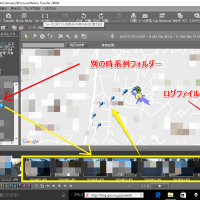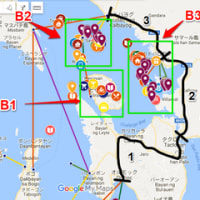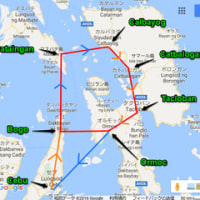After the protective coating in the morning
I went to the DIY shop to to purchase several
items. Two 6 mm wide brass pieces (two on the left),
and wooden pieces with a circular cross section
at 5 mm and 8 mm respectively. Since my bore diameter
is at 6 mm, this 5 mm thing was useless, and I knew that...
I could use it for something else. The 8 mm thing is
naturally not on, either. I will have to whittle it down,
somehow to 6 mm...
The thing is that there was nothing in between...

What follows is my brush hanger in operation...

In terms of today's physical output?


And, I tried out one of them for near completion in
assembling the members. I was so shocked...
Hole positions were only just about right.

With the illustration bellow, A is showing what I want to
do in making holes. I want the hole positions to be
the same on both pieces.
That will simplify things, and the whole idea of
making the holes (only one shown here) elongated
in two directions, as shown with the schematic C,
not like B, was to compensate for discrepancies
in hole positions. It appeared that my strategy
did not work out...
(It should have worked, and I am deeply thinking
about the pitholes...)
This is something I did not expect... and it is
slowly daunting on me that I might be facing
something quite formidable.
Ideally, you want constant positions, constant
trench depth, constant everything!
However, I am ending up with, at least,
position specific pieces, and the image above
can be seen as a mess,
with the elastic band symbolising the specifics!
That 3 main parts have to be bundled together
for position specific assembly is a blow!

What follows is showing you my scheme to seal the
trenches and the holes. Holes are easier to deal with,
because what will be protruding are on the outside
of the pieces, and can be easily sanded down, later.
What cannot be sanded down easily are the trench covers,
once all the parts have been assembled...,
as shown in the next image.

What I need are plugs for the holes, and thin pieces
of wood, as shown here. They should not be very
difficult to fabricate...

C, the schematic here, is my approach. Use a flat
brass plate, for finding out the final depth of
the trench over, by sanding out the protrusion.
You then will have the parts you want for eventual
assembly... Oh!, my God, this is not going to be an easy
project at all!



I went to the DIY shop to to purchase several
items. Two 6 mm wide brass pieces (two on the left),
and wooden pieces with a circular cross section
at 5 mm and 8 mm respectively. Since my bore diameter
is at 6 mm, this 5 mm thing was useless, and I knew that...
I could use it for something else. The 8 mm thing is
naturally not on, either. I will have to whittle it down,
somehow to 6 mm...
The thing is that there was nothing in between...

What follows is my brush hanger in operation...

In terms of today's physical output?


And, I tried out one of them for near completion in
assembling the members. I was so shocked...
Hole positions were only just about right.

With the illustration bellow, A is showing what I want to
do in making holes. I want the hole positions to be
the same on both pieces.
That will simplify things, and the whole idea of
making the holes (only one shown here) elongated
in two directions, as shown with the schematic C,
not like B, was to compensate for discrepancies
in hole positions. It appeared that my strategy
did not work out...
(It should have worked, and I am deeply thinking
about the pitholes...)
This is something I did not expect... and it is
slowly daunting on me that I might be facing
something quite formidable.
Ideally, you want constant positions, constant
trench depth, constant everything!
However, I am ending up with, at least,
position specific pieces, and the image above
can be seen as a mess,
with the elastic band symbolising the specifics!
That 3 main parts have to be bundled together
for position specific assembly is a blow!

What follows is showing you my scheme to seal the
trenches and the holes. Holes are easier to deal with,
because what will be protruding are on the outside
of the pieces, and can be easily sanded down, later.
What cannot be sanded down easily are the trench covers,
once all the parts have been assembled...,
as shown in the next image.

What I need are plugs for the holes, and thin pieces
of wood, as shown here. They should not be very
difficult to fabricate...

C, the schematic here, is my approach. Use a flat
brass plate, for finding out the final depth of
the trench over, by sanding out the protrusion.
You then will have the parts you want for eventual
assembly... Oh!, my God, this is not going to be an easy
project at all!























※コメント投稿者のブログIDはブログ作成者のみに通知されます